Manage Releases
The Releases page provides a centralized view for managing and tracking releases.
There are two ways to access the Releases page:
- Select Releases from the sidebar to view all releases.
- Go to Overview > Folders in the sidebar, then select a folder from the list to view releases within that folder.
At the top of the page, you can switch between three tabs:
- Releases: View all active, planned, in-progress, paused, failing, failed, completed, or aborted releases.
- Archive: View a list of archived releases.
- Calendar: View releases displayed in a calendar layout for better scheduling and planning.
To refine the list of releases, use the Filters button to open a sliding drawer with advanced filtering options. You can filter releases by title, owner, status, release and task tags, dates, and risk level. For quick filtering, use the Filter by title text box to instantly narrow down releases by their title.
The page displays key information for each release, including risk, title, status, completion percentage, start and end dates, and duration. You can also perform actions such as starting, aborting, or expanding releases to view more details.
Releases Tab
The Releases tab displays all releases that are active, planned, in-progress, paused, failing, failed, completed, or aborted.
Releases tab
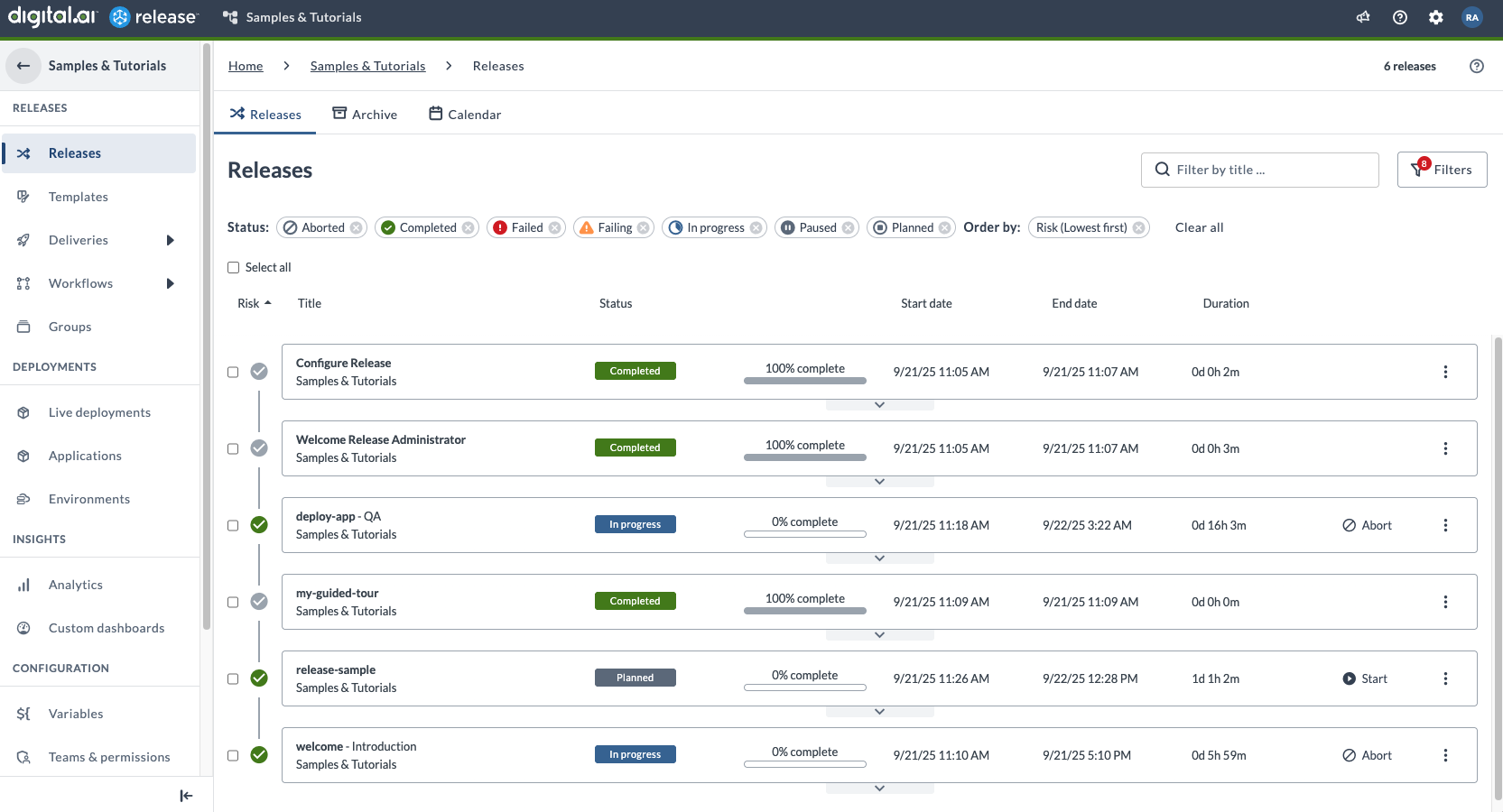
Column Details
-
Risk: Shows the risk level. For more information, see Risk Awareness.
-
Title: Shows the release title.
-
Status: Shows the release's current status (for example, Planned, In Progress, Completed).
-
Start date:
- Shows the planned start date if the release has not started.
- Shows the actual start date if the release is in progress or completed.
-
End date:
- Shows the planned end date if the release is not complete.
- Shows the actual end date when the release is completed.
note
Overdue dates are displayed in red.
-
Duration: Displays the total duration of the release.
noteThe Releases tab shows a percentage complete status based on the number of tasks completed in each release.
Here's what you can do in the Releases tab.
Create a New Release
To create a new release, click New release, fill in the required details, and click Create. The fields are:
-
Release name (required): Enter a unique name for the release.
-
Use template: (Optional) Select a template to base the release on, or choose "No template" to start from scratch.
-
Save to folder: Select the folder where the release will be stored.
-
Use risk profile: Choose a risk profile to apply to the release (default is "Default risk profile").
-
Description: (Optional) Add a description for the release.
-
Flag status: (Optional, right panel) Set a status text or flag for the release.
-
Start date / Due date: Set the planned start and due dates/times for the release. Optionally, enable "Start automatically on selected date" to schedule automatic start.
-
Duration: Displays the calculated duration between start and due dates.
-
Release Owner: The user responsible for the release (default is Release Administrator).
-
Run automated tasks as user: (Optional) Specify a user account for running automated tasks.
-
Password: (Optional) Enter a password if required for automated tasks.
-
Abort on failure: (Checkbox) If enabled, the release will abort if a failure occurs.
-
Allow passwords in all fields: (Checkbox) Allow passwords to be entered in any field.
-
Disable notifications: (Checkbox) Suppress notifications for this release.
-
Tags: (Optional) Add tags to help categorize or search for the release.
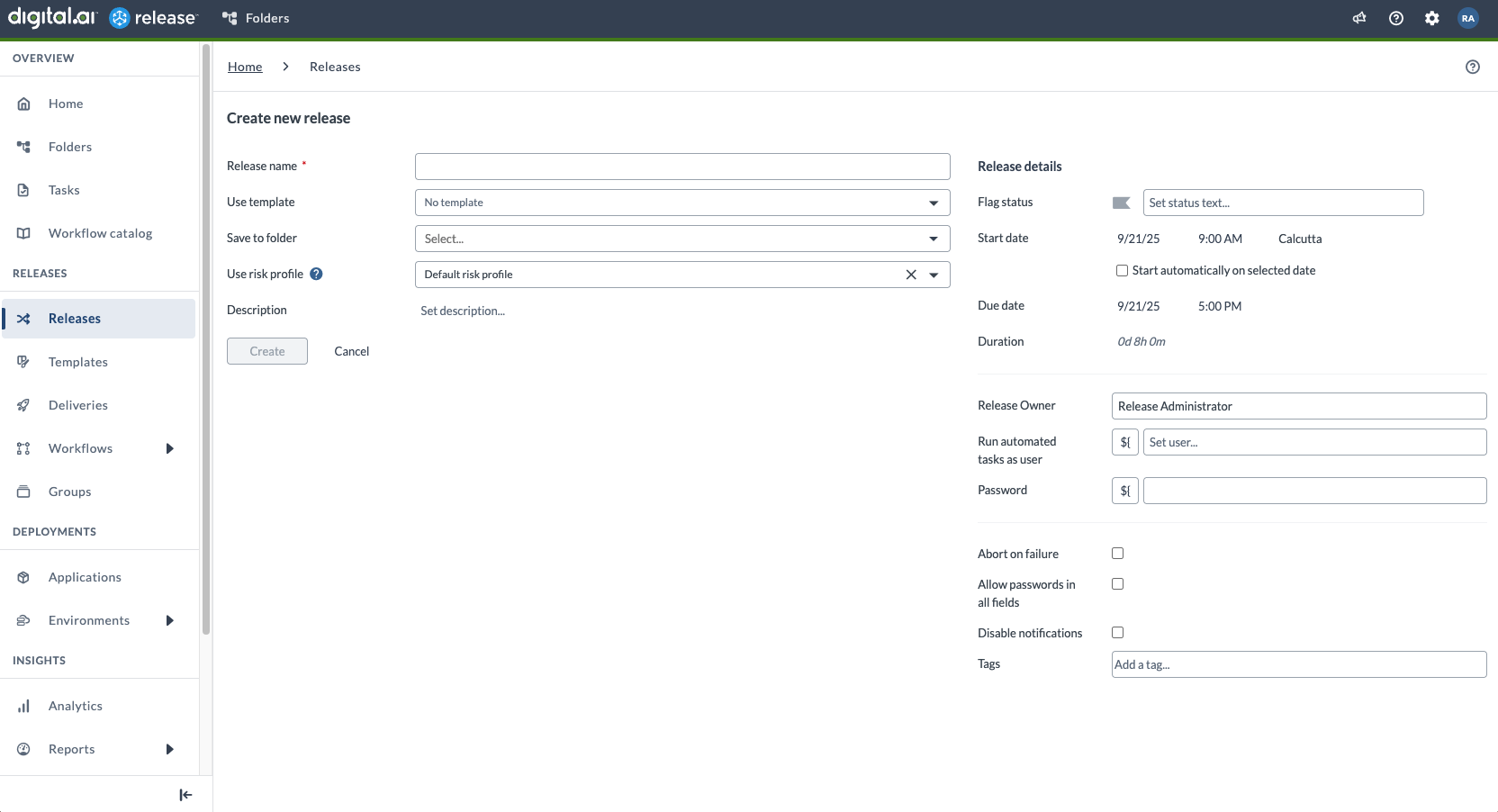
Open a Release
Click anywhere on a release row to open it in the Release Flow Editor view.
Expand Phase Pipeline
Click the expand-down arrow button next to a release to expand its phase pipeline view. This shows the completion status of each phase and any flags set on the release or its tasks. Click the arrow again to collapse the view.
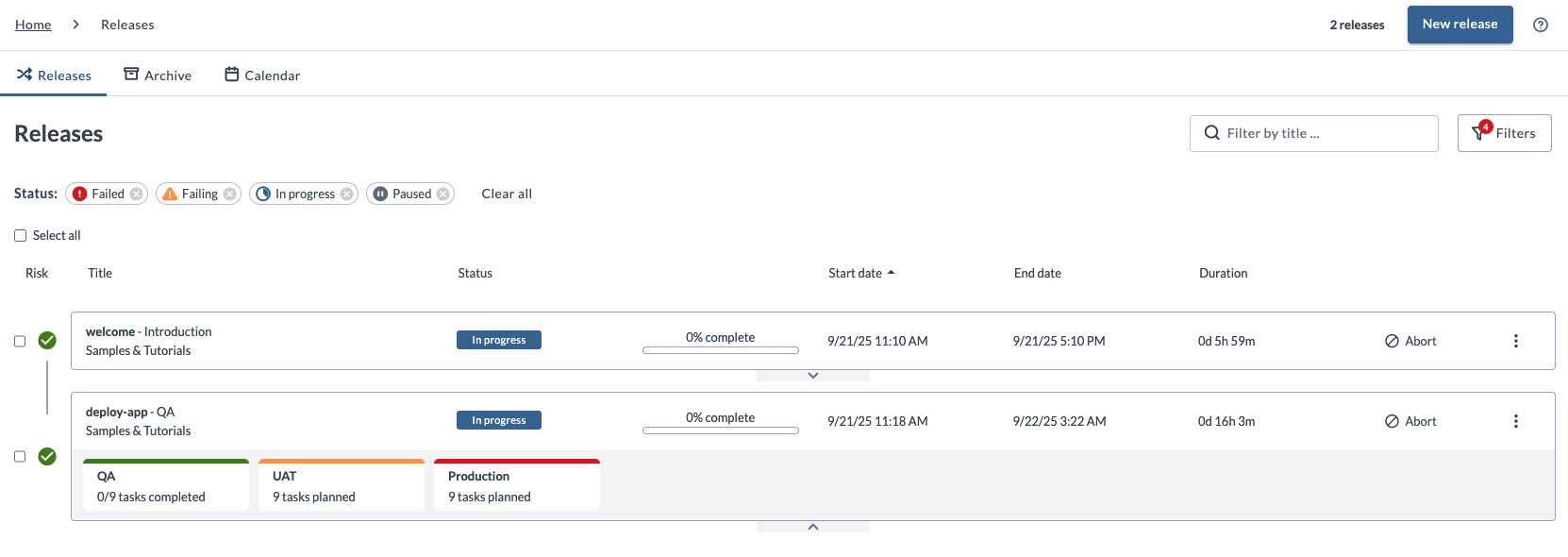
After upgrading to the latest Release version, the Releases tab will not display phase information for in-progress releases created before the upgrade until further progress is made on those releases.
Start a Release
For releases in the planned state, click Start on the right to begin the release.
Abort a Release
For active releases, click Abort on the right to stop the release.
Filtering and Sorting Releases
See:
Performing Actions on Multiple Releases
You can start or abort multiple releases at once by selecting the check boxes on the left of each release row. When you perform an action on multiple releases, only one notification email is sent to each recipient, summarizing the action and listing the affected releases.
Archive tab
You can view the list of archived releases in the Archive tab.
Archive tab
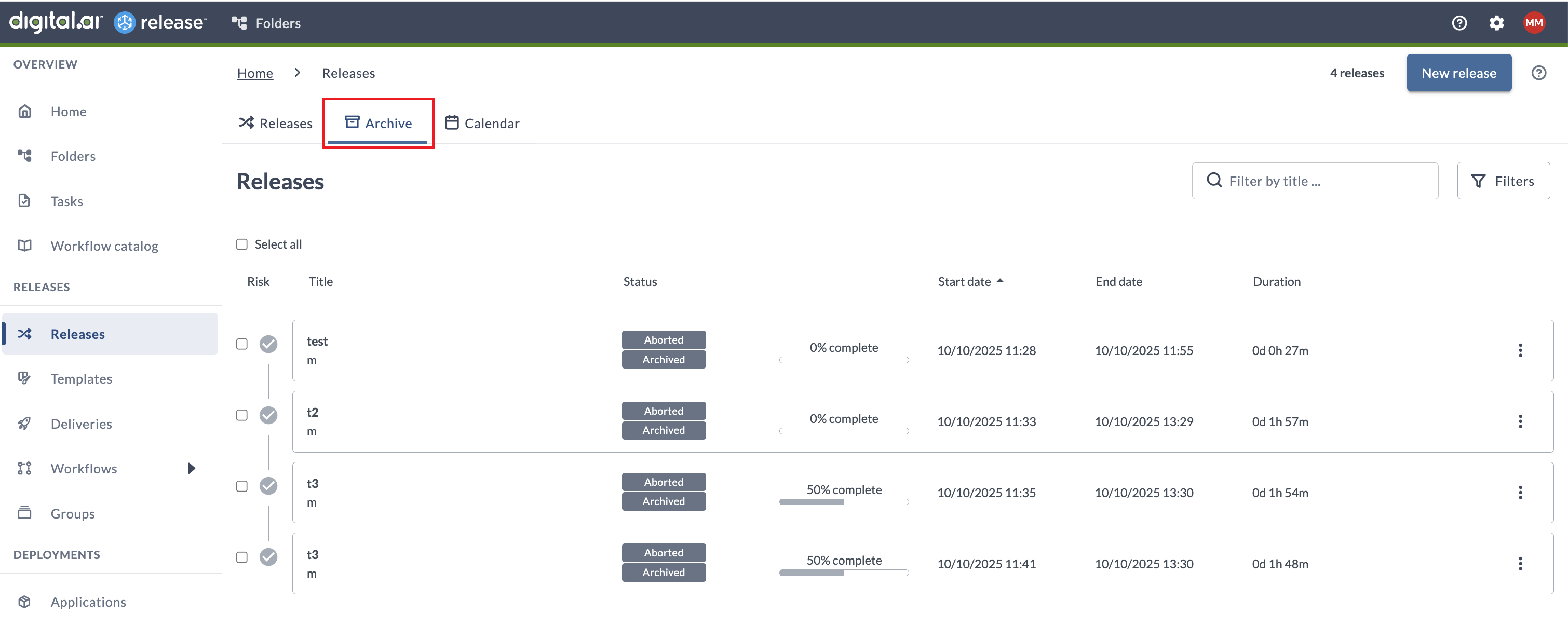
Column Details
-
Risk: Shows the risk level. For more information, see Risk Awareness.
-
Title: Shows the release title.
-
Status: Shows if the release was either Completed or Aborted, along with an Archived badge.
-
Start date:
- Shows the actual start date.
-
End date:
- Shows the actual end date.
-
Duration: Displays the total duration of the release.
noteThe Archived tab shows a percentage complete status based on the number of tasks completed in each release.
Filtering and Sorting Releases
See:
Calendar Tab
View releases displayed in a calendar layout for better scheduling and planning.
Calendar tab
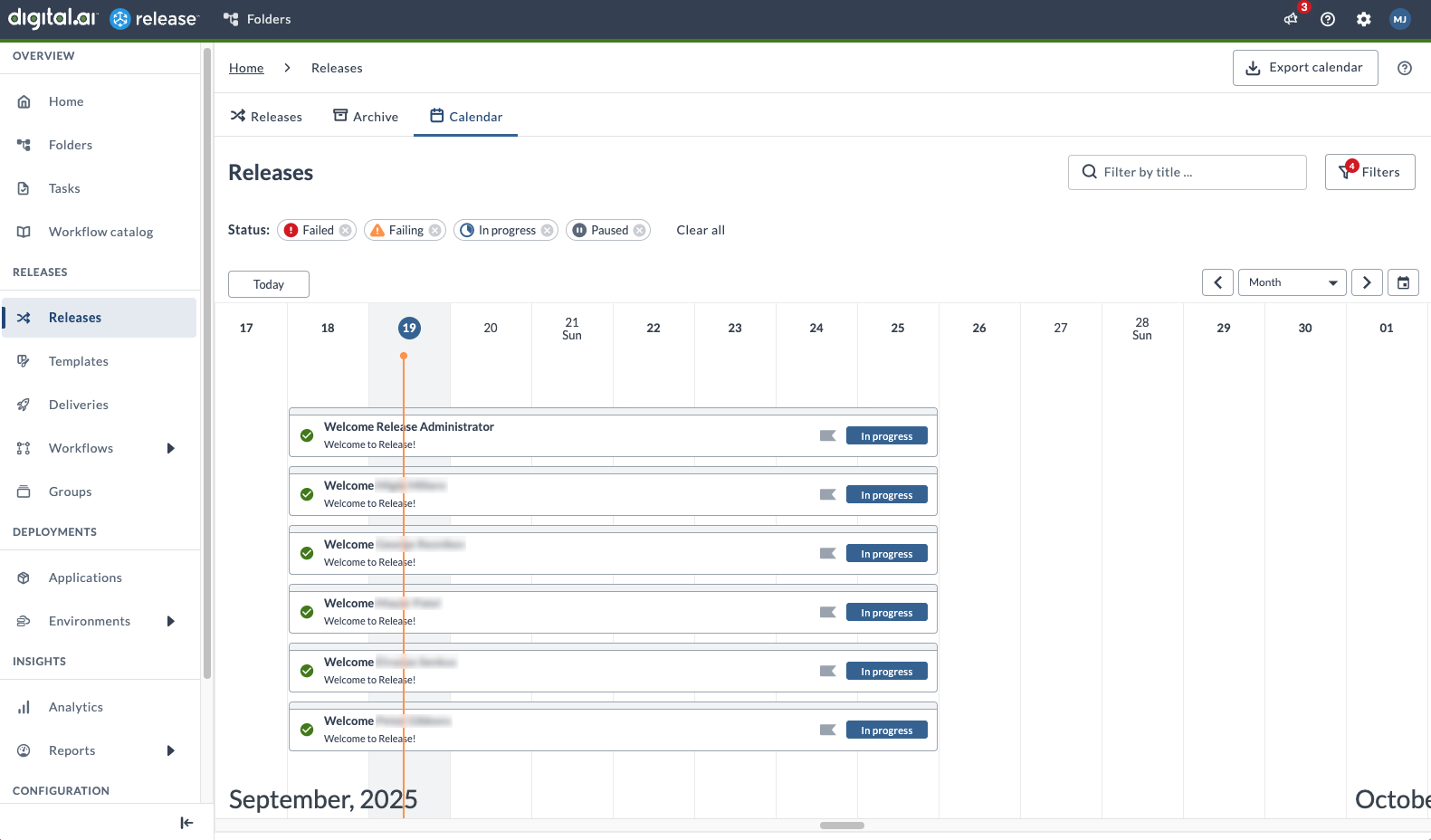
-
Use the date picker to navigate to a specific day, week, month or year.
-
Click Export calendar to export the release calendar in Excel format.
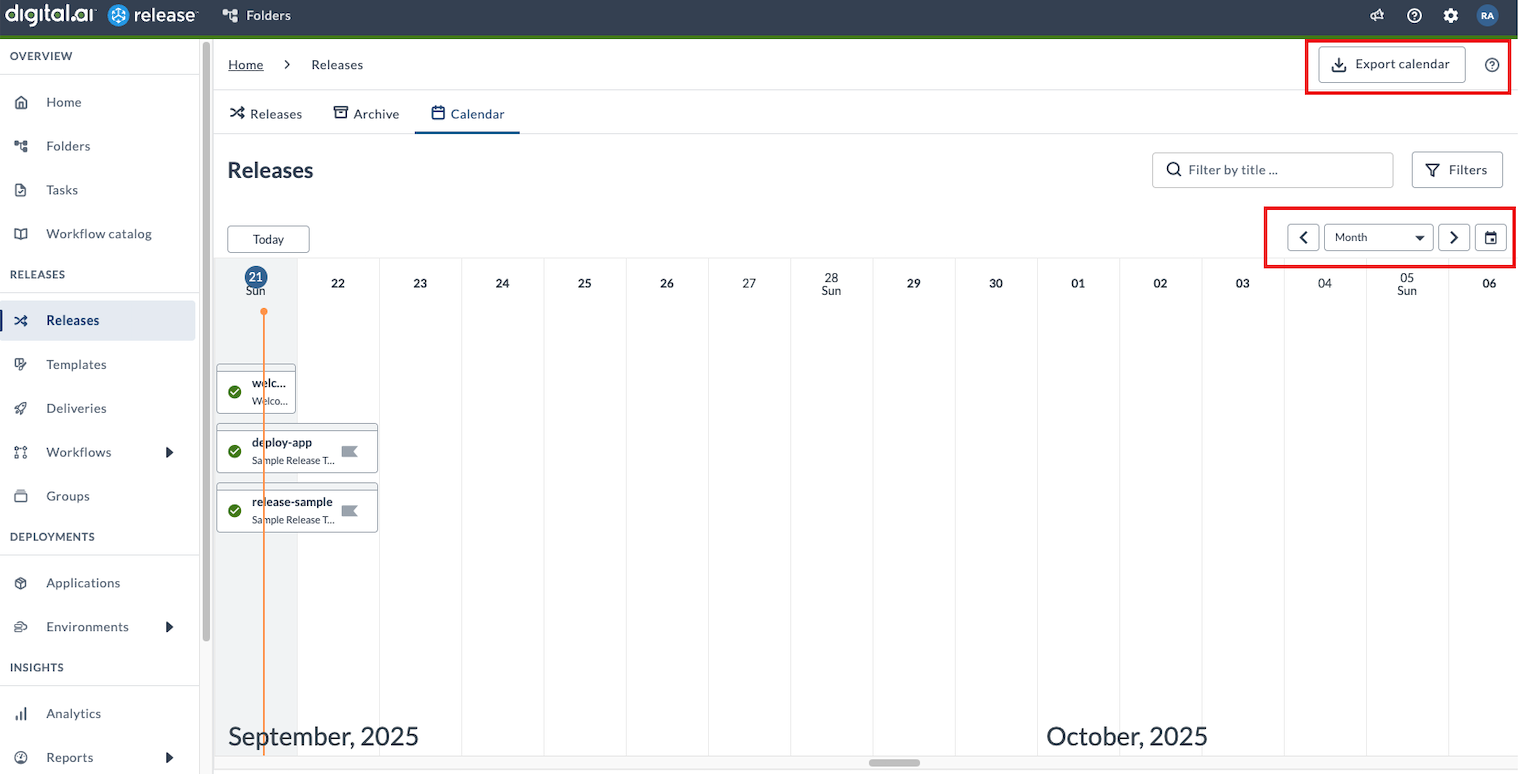
-
Hover over a release to view the release details. Click a release to view the release details pop up. Use the icons in the release details pop-up to:
-
View release (in the flow editor)
-
View dependencies
-
Download release calendar .ics file
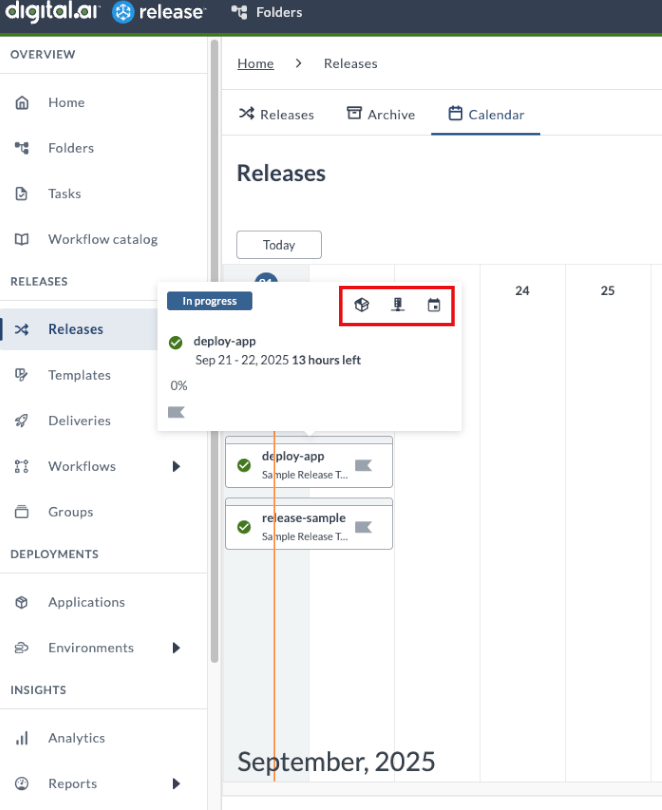
-
For more information, see Calendar View.
Filtering and Sorting Releases
See:
Filtering Releases
You can filter releases in two main ways:
-
Quick Filter by Title:
Use the Filter by title search box to instantly narrow down releases by their title.
-
Advanced Filters Drawer:
Open the Filters drawer (available in the Releases, Archive, and Calendar tabs) to apply multiple filter criteria at once.
Filters Drawer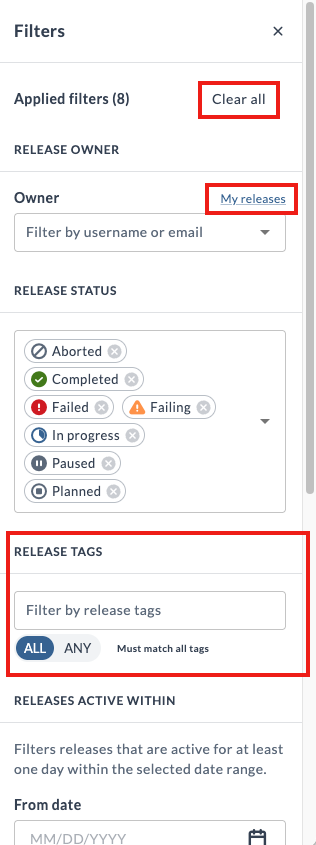
Available Filter Criteria:
- Owner: Filter by release owner name. To see only your releases, click My Releases.
- Release Status: Filter by one or more statuses:
- Planned: Releases created but not yet started (in the planned state)
- In Progress: Releases currently in progress
- Paused: Releases that are paused
- Failing: Releases that are failing
- Failed: Releases that have failed
- Aborted: Releases in the aborted state
- Completed: Releases in the completed state
- Release Tags: Filter by one or more release tags. Use the All option to show releases that include every selected tag, or Any to show releases that include at least one of the selected tags.
- Releases Active Within: Show releases active for at least one day within a selected date range.
- Flagged Releases: Toggle to show only releases flagged with a warning message (click Flagged).
- Risk Level: Filter by risk level: On Track, At Risk, or Attention Needed.
- Task Tags: Filter by one or more task tags. Shows releases that contain at least one of the selected task tags.
All filter fields support auto-complete where relevant for easier selection.
Filtering Limitations
- In the Archive tab, you can filter archived releases by Aborted and Completed status only.
- Task tag filtering is not available for archived releases (Archive tab).
- The date range filter (Releases Active Within) does not apply to the Calendar tab.
Sorting Releases
You can sort the releases list by several columns to quickly find and prioritize the releases you need. Releases are, by default, sorted by the start date (oldest first).
Available Sorting Options:
- Risk: Lowest or Highest first.
note
Sorting by risk uses the calculated risk score, showing the release with the minimum risk at the top. If multiple releases share the same minimum risk score, a secondary sort by total risk sum is applied.
- Title: Alphabetically (A–Z or Z–A).
- Status: Based on status name (A–Z or Z–A).
- Start date: Newest or Oldest first.
- End date: Newest or Oldest first.
By default, releases are sorted by Start Date (oldest first).

How to Sort
- Click any column header in the releases list table to sort by that column.
- Click the same column header again to toggle between ascending and descending order (for example, A–Z or Z��–A, oldest to latest, etc.).
Sorting helps you focus on the most relevant releases, such as those at highest risk, those starting soon, or those recently completed.